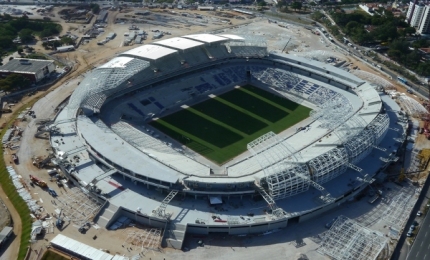
Located in Natal in Rio Grande do Norte, Brazil, Arena das Dunas is one of the five new stadiums built for FIFA World Cup 2014 and will also serve as a multipurpose arena for musical and cultural events.
The design for the new stadium was provided by the sports architecture company Populous, while the Natal Arena consortium was in charge of the construction.
The stadium was officially opened in January 2014 and will also be the home stadium for two local football teams, namely ABC and América, for whom the Dunas Arenas consortium will manage the stadium for the next 20 years.
Inspiration and design of Arena das Dunas
The arena, comprising of the stadium and the performing arts complex, stands on a raised ground surrounded by a park. Named as ‘The Stadium of the Dunes’, the design of the sports venue is inspired by the sand dunes, which are commonly found in Natal.
The wavy structure of the arena was designed keeping in mind the location’s climatic conditions. The structure shields spectators from direct sunlight, while allowing the main stands to catch on shore breeze. The air flows via the ETFE (Ethylene Tetrafluoroethylene) louvers into the seating bowls located between the stadium shells.
Designed by architect Christopher Lee, the stadium roof features 20 petal-like forms connected by a continuous wavy foyer. The uneven petal-shaped structures resemble the moving sand dunes.
Stadium structure and construction
The construction of the Brazilian football stadium began with the demolition of the João Claudio de Vasconcelos Machado or the ‘Machadão’, an old stadium built in 1972, covering part of the construction site for the new stadium.
The Dunas Arena covers more than 77,000m². The arena is divided into four sectors measuring 271m long and 248m wide. Each side of the stadium has three or four levels.
The stadium stands 50.5m high from the pitch to the tallest point on the roof. The pitch of the stadium, located 15m away from the first row of the stands, measures 105m long and 68m wide. Internationally certified Bermuda Tifton 419 species of grass was used for the pitch. This particular species of grass is appropriate for the local climate, as it allows the game to continue even during very rainy days.
The petal shaped structures of the roof are made of steel trusses, which are coated with aluminium tiles on the outside with thermal and acoustic insulation. They are internally coated with a PVC prestressed membrane.
The sports arena construction took 29 months for completion and involved approximately 4,500 workers.
Facilities at Arena das Dunas
Accesses to the stadium is provided by 21 ramps which get people to one of the four levels of venue. In addition to elevators, there are also 18 staircases and three adapted ramps at the venue. Lifts connect the indoor car park facility directly with 39 boxes.
The Arena features four lounges capable of accommodating up to 1,000 people. It has 25 food and drink kiosks and 30 lavatories. The two major arrival points to the ground are through Prudente de Moraes Avenue and Salgado Filho Avenue. The venue’s parking area offers spaces for approximately 2,500 cars.
The seating categories for general public include ‘VIP’, ‘Very VIP’ and ‘Hospitality’. All seats at the stadium are coloured with different shades of blue, have backrest and are retractable. 521 seats are reserved for people with disabilities. During the 2014 World Cup, the stadium has a seating capacity of 42,000 people, which will be reduced to 31,375 after completion of the event.
The control centre of the stadium is equipped to monitor video recordings of 200 cameras, situated in the ground’s external and internal areas, with facial recognition technology. The stadium features two 64m² screens with an integrated public announcement system for displaying information and match statistics.
Arena Corinthians is a new football stadium constructed in Itaquera, near the city of São Paulo, Brazil.
The stadium is fitted with over 300 floodlights, strategically positioned not to create shadows on the pitch. The uniform lighting enables clear visibility of the HDTV broadcastings from the stadium. The stadium uses four 750KVA generators to tackle power failure issues.
The stadium also has 80 positions for live-telecasting the matches and a press conference area for 250 people.
Sustainability of Arenas das Dunas
The Dunas Arena’s roof is equipped with a rainwater capture system. The collected rainwater is reused in the lavatories and pitch irrigation.
Wastes weighing between two and four tonnes were produced every month during the construction. All the recyclable materials collected were stored at the building site and were then handed over to a co-operative, which screened and then sold them to the recycling industry.
Financing for the stadium
The total investment for the stadium project is estimated to be BRL400m ($170m) and was mostly financed by the Brazilian federal Government.
Details of the multipurpose arena
The Arenas das Dunas has been designed to be a multipurpose venue. The arena is located 13km away from Augusto Severo Airport and 5km from the city. The auditorium at the venue can accommodate 250 people.









